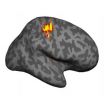(Press-News.org) In type 1 diabetes, the immune system destroys insulin-producing cells in the pancreas, but the precise cause has not been clear. A study published by Cell Press on March 5th in Cell Metabolism reveals that a single mutation in the "longevity gene" SIRT1 can cause type 1 diabetes in humans. The findings unearth the role this gene plays in human autoimmunity and disease and also offer new avenues for treating a range of autoimmune disorders.
"We describe one of the first single gene defects leading to type 1 diabetes, as well as the first human mutation in the SIRT1 gene," says senior study author Marc Donath of University Hospital Basel. "Our findings reveal a potential mechanistic basis for the development of a treatment for type 1 diabetes and other autoimmune diseases."
Type 1 diabetes is a lifelong, potentially fatal disease, typically diagnosed in young individuals, in which beta cells in the pancreas do not produce enough of the hormone insulin, resulting in high levels of blood sugar. Animal studies have shown that a gene called SIRT1, which is well known for its role in promoting longevity and protecting against age-related diseases, also regulates insulin secretion and the development of autoimmune conditions, and activation of this gene can protect against type 1 diabetes. But until now, the role of SIRT1 in human autoimmunity and disease was not known.
In the new study, Donath and his team described a family carrying a mutation in the SIRT1 gene. All five affected members developed an autoimmune disorder, and four developed type 1 diabetes. Using a combination of gene-sequencing techniques, the researchers identified a previously undocumented mutation that caused an amino acid substitution in the SIRT1 protein. Moreover, inactivation of the SIRT1 gene in mice led to the destruction of the insulin-producing region of the pancreas, resulting in high levels of blood sugar.
"The identification of a gene leading to type 1 diabetes should allow us to understand the mechanism responsible for the disease and may open up new treatment options," Donath says. "To follow up on this study, we are creating a mouse that carries the mutation, with the hope of developing an animal model for human type 1 diabetes, and we are exploring the possibility of conducting a clinical study with SIRT1 activators."
INFORMATION:
Cell Metabolism, Biason-Lauber et al.: "Mutation of SIRT1 in a Family with Type 1 Diabetes."
Discovery of human genetic mutation could lead to new treatments for type 1 diabetes
2013-03-05
ELSE PRESS RELEASES FROM THIS DATE:
Molecular coordination in evolution: A review in 'Nature Reviews Genetics'
2013-03-05
Spanish National Cancer Research Centre (CNIO) researchers Alfonso Valencia, Director of the Structural Biology and Biocomputing Programme and David de Juan, jointly with Florencio Pazos, from the Spanish National Centre for Biotechnology (CNB-CSIC), publish a review on the latest computational methods that, based on evolutionary principles, are revolutionising the field of analysis and prediction of protein structure, function and protein-protein interactions, as well as the short- and long-term expectations for the field.
"The computational and mathematical analysis ...
How cells optimize the functioning of their power plants
2013-03-05
Mitochondria, which are probably derived from distant bacterial ancestors incorporated into our cells, have their own DNA. However, we know little about how these organelles, which convert oxygen and consumed nutrients into energy, regulate the expression of their own genes. Jean-Claude Martinou, professor at the University of Geneva (UNIGE), Switzerland, and his team, have discovered the existence of compartments at the heart of mitochondria, consisting of hundreds of different proteins. It is here that RNA molecules (the many copies made from DNA) come together to be ...
Single gene might explain dramatic differences among people with schizophrenia
2013-03-05
March 5, 2013 (Toronto) – Some of the dramatic differences seen among patients with schizophrenia may be explained by a single gene that regulates a group of other schizophrenia risk genes. These findings appear in a new imaging-genetics study from the Centre for Addiction and Mental Health (CAMH).
The study revealed that people with schizophrenia who had a particular version of the microRNA-137 gene (or MIR137), tended to develop the illness at a younger age and had distinct brain features – both associated with poorer outcomes – compared to patients who did not have ...
Viruses: More survival tricks than previously thought
2013-03-05
Among eukaryotes with modified nuclear genetic codes, viruses are unknown. Until now it had been believed that the modifications to the genetic code effectively prevented new viral infections. However, researchers have now reported the first example of a virus that can be shown to have crossed the boundary from organisms using the standard genetic code to those with an alternate genetic code.
"The finding is significant because it means that virus-host co-evolution after a genetic code shift can be more extensive than previously thought", said researcher Derek J. Taylor, ...
West Nile virus passes from female to eggs, but less so from larvae to adults
2013-03-05
In California Culex mosquitoes are considered to be the principle vectors of West Nile virus (WNV), which infects birds, humans, and other mammals during the summer. In addition, these mosquitoes may also serve as overwintering reservoir hosts as the virus is passed "vertically" from female mosquito to egg, then larva, and then adult.
To find out how often this happens, California researchers monitored WNV in mosquitoes in the field and in the lab, and observed how the virus is transmitted between generations and between insect stages. The results are published in the ...
Remains of extinct giant camel discovered in High Arctic by Canadian Museum of Nature
2013-03-05
Ottawa, Canada, March 5, 2013 - A research team led by the Canadian Museum of Nature has identified the first evidence for an extinct giant camel in Canada's High Arctic. The discovery is based on 30 fossil fragments of a leg bone found on Ellesmere Island, Nunavut and represents the most northerly record for early camels, whose ancestors are known to have originated in North America some 45 million years ago.
The fossils were collected over three summer field seasons (2006, 2008 and 2010) and are about three-and-a-half million years old, dating from the mid-Pliocene ...
Amputee phantom pain linked to brain retaining picture of missing limb
2013-03-05
Changes in the brain following amputation have been linked to pain arising from the missing limb, called 'phantom pain', in an Oxford University brain imaging study.
Arm amputees experiencing the most phantom limb pain were found to maintain stronger representation of the missing hand in the brain – to the point where it was indistinguishable from people with both hands.
The researchers hope their identification of brain responses correlated with the level of phantom pain can aid the development of treatment approaches, as well as increase understanding of how the brain ...
Ancient DNA solves 320-year-old mystery
2013-03-05
University of Adelaide researchers have found the answer to one of natural history's most intriguing puzzles – the origins of the now extinct Falkland Islands wolf and how it came to be the only land-based mammal on the isolated islands – 460km from the nearest land, Argentina.
Previous theories have suggested the wolf somehow rafted on ice or vegetation, crossed via a now-submerged land bridge or was even semi-domesticated and transported by early South American humans.
The 320-year-old mystery was first recorded by early British explorers in 1690 and raised again ...
Mental picture of others can be seen using fMRI, finds new study
2013-03-05
ITHACA, N.Y. – It is possible to tell who a person is thinking about by analyzing images of his or her brain. Our mental models of people produce unique patterns of brain activation, which can be detected using advanced imaging techniques according to a study by Cornell University neuroscientist Nathan Spreng and his colleagues.
"When we looked at our data, we were shocked that we could successfully decode who our participants were thinking about based on their brain activity," said Spreng, assistant professor of human development in Cornell's College of Human Ecology.
Understanding ...
Children of divorced parents more likely to switch, pull away from religions, Baylor study finds
2013-03-05
Adults whose parents were divorced are more likely to switch religions or disassociate themselves from institutional religions altogether — but growing up in a single-parent family does not have any effect on private religious life, including praying, according to a study by a Baylor University sociologist.
The findings also suggest that being a child of divorced parents is not in itself as important a factor in a person's religious life as previous research has indicated, according to Jeremy Uecker, Ph.D., an assistant professor of sociology in Baylor's College of Arts ...



